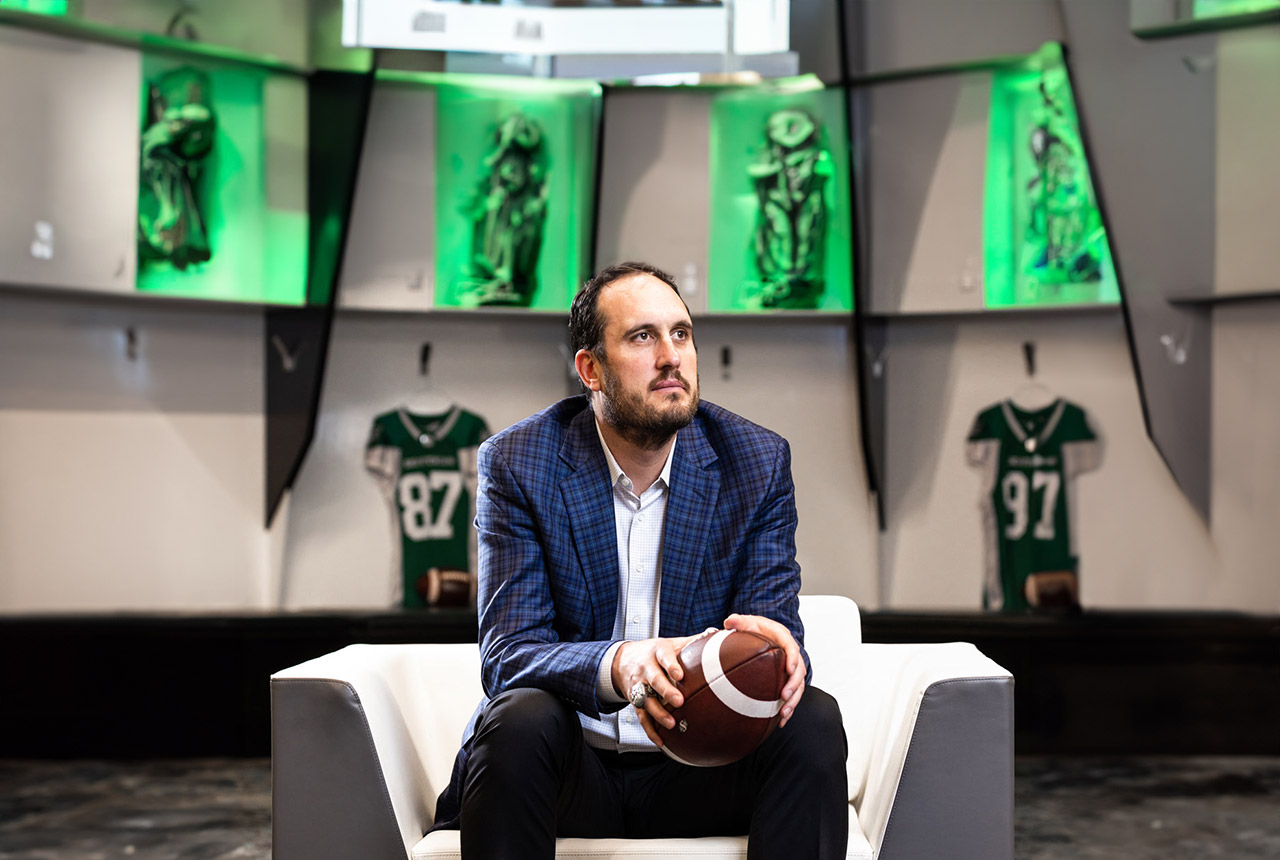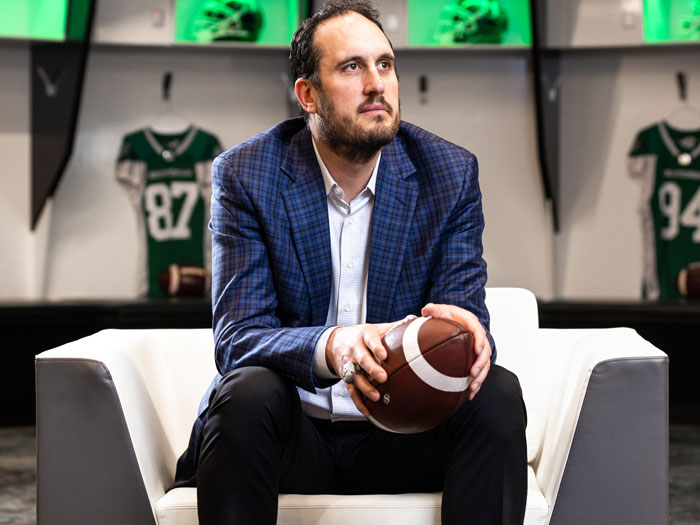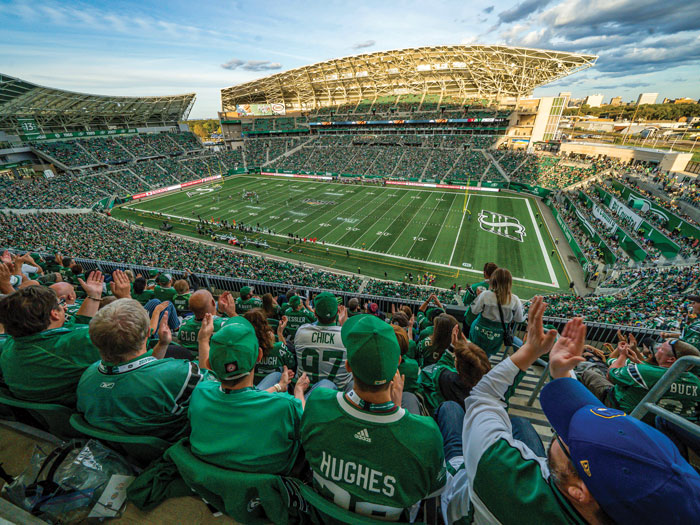
Meet the CPA rebuilding the CFL from the ground up
 Craig Reynolds is the president and CEO of the Saskatchewan Roughriders, and a longtime fan (Photography by Tandem X Visuals)
Craig Reynolds is the president and CEO of the Saskatchewan Roughriders, and a longtime fan (Photography by Tandem X Visuals)
In the 13 years since Craig Reynolds joined the Saskatchewan Roughriders organization, he’s watched the team evolve. First as its CFO and now president and CEO, the 46-year-old Saskatchewan-raised CPA has seen the team emerge from decades of financial turmoil to become one of the most stable franchises in the Canadian Football League.
The league’s nine teams were hit hard by the pandemic, which forced the cancellation of the 2020 season. But the Roughriders aren’t like most teams.
They are one of three community-owned teams in the CFL (along with the Winnipeg Blue Bombers and Edmonton Elks), meaning that instead of a traditional ownership group at the helm, the club’s shareholders are its fans, who can purchase shares and get a say in electing the club’s Board of Directors. The arrangement, which is rare in professional sports (the NFL’s Green Bay Packers are the only similar example in North America outside of the CFL), is one of the main reasons why the bond between fan and team is as strong as any you’ll find in the sporting world. But, without a wealthy owner with deep pockets at the helm, able to sustain operations during a lean period, the community-based ownership model also created uncertainty during the pandemic when the team was unable to earn revenue.
The 2020 ghost season ended up costing the Roughriders a record loss of $7.5 million that year. “It was the biggest financial crisis the club had ever faced,” says Reynolds, “And that’s a pretty big statement when you put it into the context of the franchise’s history.”
The rest of the league didn’t fare any better. Without a product on the field, the CFL lost an estimated $80 million during the first year of the pandemic. Other major leagues, buoyed by billion-dollar television contracts and lucrative partnerships, could deliver a product even without fans in the stands. Not the CFL, a gate-driven business that relies heavily on ticket sales to be profitable. (By comparison, the National Basketball Association, which played its games without fans, saw its revenue drop 10 per cent, but still managed to earn US$8.5 billion.). The pandemic could have been a death sentence to a league that was already struggling to grow its audience and attract new fans.
But, in the face of potential disaster, Reynolds, who also serves on the CFL’s board of governors, went to work devising a strategic plan to not just keep his team afloat, but also help the CFL come out of the pandemic stronger than ever.
Craig and I talked many times about the opportunity that laid in front of us,” says CFL commissioner Randy Ambrosie. “Like Winston Churchill said: ‘Never waste a crisis.’”
There are two seconds remaining in the 77th annual Grey Cup between the Hamilton Tiger-Cats and Saskatchewan Roughriders and the score is tied at 40 apiece. It’s November 26, 1989. Surrounded by 55,000 fans at the SkyDome in downtown Toronto, Roughriders kicker Dave Ridgway approaches the 28-yard line and readies himself for the most important kick of his life. It had been 11 years since the Roughriders had reached the playoffs and 23 long years since the team won its first and only Grey Cup. Now, they were one field goal away from one of the most improbable championships in CFL history.
In the town of Foam Lake, Sk., 2,500 kilometres away, a large group is gathered in the basement of the Reynolds family home, huddled around a television screen. Ridgway winds up and delivers a booming kick and, for 13-year-old Craig Reynolds, it’s a moment he’ll never forget. From his vantage point, the kick looks like it went wide of the goalpost and missed. Another in a long line of Riders heartbreaks. It’s only when the room erupts in joy a moment later that he realizes Ridgway’s kick was good and his Roughriders had won it all. A celebration breaks out, with Craig playing disc jockey and spinning records into the morning hours. It’s not the last time he’ll be front and centre celebrating his favourite team’s success.
 Pre-pandemic, the team’s biggest project was the development of the $278-million, 38,000-seat Mosaic Stadium (Photography by Tandem X Visuals)
Pre-pandemic, the team’s biggest project was the development of the $278-million, 38,000-seat Mosaic Stadium (Photography by Tandem X Visuals)
Like many kids from the prairies, Reynolds was born into “Rider Nation.” He was enamoured with football—the strategy and critical thinking that went into each and every play—and would plead to his father, a season-ticket holder, to take him to as many Roughriders games as possible. On the two-and-a-half-hour drive from Foam Lake to Regina, they passed through wheat and canola fields until Taylor Field—now Mosaic Stadium—would appear on the horizon. “Back then, not every game was on television, so it was a real event when you got to go to a game,” says Reynolds. “I didn’t take it for granted at all.”
After going winless in six games as quarterback of the Foam Lake high school football team, Reynolds dropped any aspiration to don the green and white. Instead, with a growing interest in finance and banking, he set his sights on accounting, earning a masters degree in professional accounting (MPAcc) from the University of Saskatchewan in 1999 before becoming a CPA.
“I remember studying for the UFE at the time thinking, ‘I want to commit to this because it might lead to some great life experiences.’ Those opportunities seemed endless once you had that designation.”
He landed a job with KPMG in Saskatoon but, craving adventure, began exploring international transfer opportunities—until the World Trade Centre attacks happened in 2001 and transfers were put on pause. One office, however, was still accepting international transfers: Luxembourg City. Reynolds jumped at the opportunity—mostly for the chance to easily travel throughout mainland Europe. In 2003, he moved to London, England to work for Thomson Scientific as a senior revenue accountant before returning to Canada two years later as a senior manager with Suncor Energy in Calgary, where many CPAs from Saskatchewan had settled in positions in the energy sector. Reynolds then took a transfer to Fort McMurray to become a project leader with the company’s oil sands cost management program.
When he noticed that the Roughriders were hiring a chief financial officer in 2009, Reynolds applied. “He definitely had the background we were looking for in terms of education and experience,” says then-CEO Jim Hopson, a Saskatchewan native and former Roughriders player. “But the thing I liked about him is that he was a small-town Saskatchewan boy. He had the accounting background, a passion for the Riders and he really wanted the job,” he says. “We felt good about what he could bring [to the role].”
At the time, the Roughriders franchise was on a growth trajectory following a lengthy transitioning phase from a smaller, volunteer-led organization into a profitable business. Roughriders fans regularly pack their stadium and more Saskatchewanians tune in to watch their team on TV compared to any other fan base in the CFL. But, without a traditional owner or ownership group steering the organization toward gaining financial returns, it hasn’t always led to profits. Reynolds considers his team fortunate in this regard (“we’re in a position to be able to steward the organization the right way,” he says). But it has led to some tough times in Rider Nation.
“People tend to think that it was always this good in Riderville in Saskatchewan, but it wasn’t. I was there,” says Ambrosie, who played in the CFL from 1985 to 1993. Despite a dedicated fan base, in the 1980s, the RoughRiders were in financial turmoil and perennially on the brink of folding. In 1987—just two years before their Grey Cup victory— the club even held a telethon asking for fan donations to keep the team in business. Progress was slow. “In my first year, we made a profit of four hundred dollars,” says Hopson, who was named team president in 2005.
On the field, however, things were trending up. Grey Cup victories in 2007 and 2013 coincided with a period of economic growth in the province. As revenues reached record levels (in 2014, the team announced $10.4 million in profits, up from $2.2 million five years earlier) the organization was putting a concerted effort into growing the business under Reynolds’s direction. He’d added senior vice-president to his title and the team was building financial processes, modernizing revenue growth models and reinvesting earnings toward things like facilities upgrades.
By 2014, when Hopson announced his retirement, the team had managed to build a reserve fund of $40 million. Impressed with his stewardship and measured approach, Hopson encouraged Reynolds to apply for the CEO role.
“I went back to 13-year-old Craig watching the ’89 Grey Cup,” says Reynolds. “I thought, ‘The opportunity to effectively run the day-to-day organization that you grew up loving?’ I couldn’t turn that down.”
As CEO, Reynolds is involved in virtually every aspect of the team’s operations—from season-ticket sales to facility management, hiring team personnel, growing the business and engaging with the Roughriders community, where he has become a recognizable face of the team. One of the perks? He regularly interacts with his childhood heroes from the ’89 championship team, who, like many former Roughriders players, show up to home games and sustain a bond with the organization and fan base. Today, Reynolds considers players like Grey Cup hero Dave Ridgway, close friends.
Prior to the pandemic, Reynolds and the Roughriders’ biggest undertaking was the development of Mosaic Stadium, the team’s $278 million 38,000-seat open-air stadium that opened five years ago. It was a ten-year process from ideation to taking the field and involved three levels of government and a major commitment from the fans. The team engineered shared economic model that featured funding from the city, an $80 million grant and a $100 million loan from the province to be repaid over 30 years with money generated from a $12 fee built into the price of each Roughriders ticket. “Ultimately the fans were the biggest source of funding.”
“We’ve been rebuilding the foundation on which the league sits over these last two years”
Another wave of COVID-19 postponed the scheduled start of the 2021 season but, on August 5, 2021, after a year hiatus, professional football returned in Canada. Teams began preparations months earlier, following provincial guidelines and consulting with medical experts to develop health and safety protocols. Initially slated for 18 games, the season was reduced to 14. It turned out to be a tremendous season for Saskatchewan, who hosted a playoff game (“That,” says Reynolds, “is a profitable endeavour.”) and reached the semi-finals. For the league, the season marked the first step in a new direction—and created optimism around the current 2022 campaign.
“We’ve been rebuilding the foundation on which the league sits over these last two years,” says Ambrosie, who points to the “team stabilization plan” as an example. The plan is a revenue-sharing model common in pro sports leagues that sees the most profitable teams sharing the wealth with the weaker clubs. The plan helps to ensure the financial strength of the league’s nine franchises, with the strongest teams, like the Roughriders, sharing revenue with the weakest. It had been 40 years since the league last used a revenue-sharing model. Ambrosie credits Reynolds for taking a leading role in the development of the platform. “He was able to see the big picture and ask, ‘How do we build a stronger CFL together?’ Craig is staggeringly thoughtful, very measured and logical,” he says. “And that’s of huge value among our league management council.”
“One of the biggest things I’ve found during the pandemic is the problem-solving skills you develop by being a CPA,” Reynolds says. “A lot of the work was financial modeling and cash-flow modeling and analysis, and having that base understanding to be able to question or understand these things on a deeper level was critical. I use skills as a CPA in my job on a daily basis.”
Ahead of the 2022 season, the CFL focused on strategic partnerships and, in December 2021, announced what Ambrosie calls a “transformational” deal with UK-based Genius Sports, a sports data and technology supplier that has been contracted by the likes of the NFL, PGA Tour and English Premier League. The CFL plans to enhance their product by leveraging Genius’s portfolio—which includes a sports technology business, sports betting platform and digital broadcast support program—to bolster engagement with existing fans while reaching new fans in Canada and beyond.
In Regina, Reynolds is quick to deflect credit for keeping his team afloat during the pandemic to its community of dedicated fans, who he calls “the sole reason” for surviving “The sole reason we were able to survive was the commitment of our fans who kept their season ticket money with us.”
“I go to work with such purpose everyday because I know how much it means to our fan base and the people of Saskatchewan,” says Reynolds. “And how do I know it means so much to them? Because it means so much to me.”
There was a particularly hectic day early in Reynolds’ tenure when, during a down moment, he was chatting with Hopson.
“I can’t believe this job,” he said. “It’s all-consuming! Every little decision is questioned and scrutinized.’”
“That’s the great thing about the Riders,” Hopson told him. “Everybody cares.”
MEET OTHER INSPIRING CPAS
Read about the CPA who leads guided fly-fishing expeditions; the plant-based burger business owner who left the corporate world and the CPAs using social media to share financial knowledge.